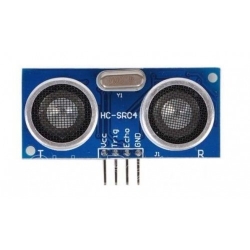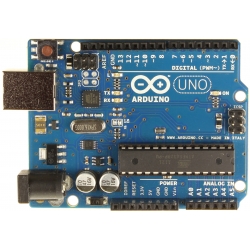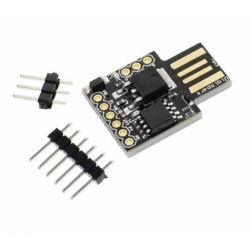ARDUINO

-
Ultrasonic Distance Sensor ()
ultrasonic sensor provides an easy method of distance measurement. This sensor is perfect for any number of applications that require you to perform measurements between moving or stationary objects.
Interfacing to a microcontroller is a snap. A single I/O pin is used to trigger an ultrasonic burst (well above human hearing) and then "listen" for the echo return pulse. The sensor measures the time required for the echo return, and returns this value to the microcontroller as a variable-width pulse via the same I/O pin.
Application Ideas:
- Security systems
- Interactive animated exhibits
- Parking assistant systems
- Robotic navigation
Add to Cart2.98€ -
Arduino UNO R3 ( UNO R3)
Microcontroller ATmega328 Operating Voltage 5V Input Voltage (recommended) 7-12V Input Voltage (limits) 6-20V Digital I/O Pins 14 (of which 6 provide PWM output) Analog Input Pins 6 DC Current per I/O Pin 40 mA DC Current for 3.3V Pin 50 mA Flash Memory 32 KB (ATmega328) of which 0.5 KB used by bootloader SRAM 2 KB (ATmega328) EEPROM 1 KB (ATmega328) Clock Speed 16 MHz The power pins are as follows:
- VIN. The input voltage to the Arduino board when it's using an external power source (as opposed to 5 volts from the USB connection or other regulated power source). You can supply voltage through this pin, or, if supplying voltage via the power jack, access it through this pin.
- 5V.This pin outputs a regulated 5V from the regulator on the board. The board can be supplied with power either from the DC power jack (7 - 12V), the USB connector (5V), or the VIN pin of the board (7-12V). Supplying voltage via the 5V or 3.3V pins bypasses the regulator, and can damage your board. We don't advise it.
- 3V3. A 3.3 volt supply generated by the on-board regulator. Maximum current draw is 50 mA.
- GND. Ground pins.
- IOREF. This pin on the Arduino board provides the voltage reference with which the microcontroller operates. A properly configured shield can read the IOREF pin voltage and select the appropriate power source or enable voltage translators on the outputs for working with the 5V or 3.3V.
Add to Cart23.80€ -
Digispark Kickstarter Development Board ATTINY85 Module for Arduino usb (ATTINY85)Description:
1. Support for the Arduino IDE 1.0 + (OSX/Windows/Linux).
2. Power via USB or External Source or 7-16 v to 5 v (automatic selection).
3. The On - board, 150 ma 5 v Regulator.
4. Built - in USB and serial was debugging).
5. 6 I/O Pins (2 are informs the for USB only if your program actively communicates over USB, otherwise you can use all 6 even if you are programming via USB).
6. 8 k Flash Memory (about 6 k after bootloader).
7. The I2C and SPI (vis USI).
8. PWM on 3 pins (more possible with Software PWM).
9. The ADC on 4 pins.
10. The Power LED and the Test/Status leds.
The Specs:
1. Support for the Arduino IDE 1.0+ (OSX/Win/Linux).
2. Power via USB or External Source - 5v or 7-16v (automatic selection).
3. On-board 150ma 5V Regulator.
4. Built-in USB (and serial debugging).
5. 6 I/O Pins (2 are used for USB only if your program actively communicates over USB, otherwise you can use all 6 even if you are programming via USB).
6. 8k Flash Memory (about 6k after bootloader).
7. I2C and SPI (vis USI).
8. PWM on 3 pins (more possible with Software PWM).
9. ADC on 4 pins.Add to Cart4.17€



